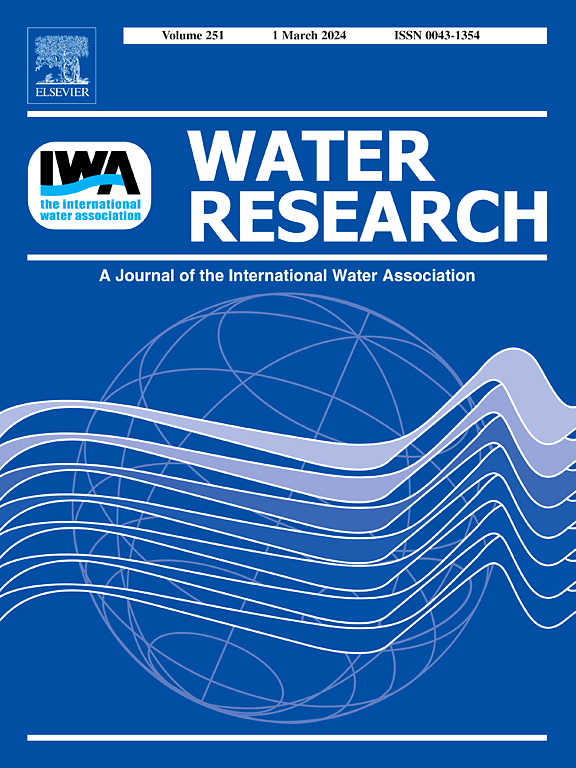Transport dynamics of microplastics within aquatic vegetation featuring realistic plant morphology
IF 11.4
1区 环境科学与生态学
Q1 ENGINEERING, ENVIRONMENTAL
引用次数: 0
Abstract
Despite the significance of rivers and streams in transporting terrestrial microplastics (MP) to the oceans, limited research has focused on the role of aquatic vegetation and their complex geometry in shaping the underlying mechanisms governing MP mixing and dispersion processes in riverine environments. This study, for the first time, investigates the transport and fate of non-buoyant MPs, specifically those with diameters of 188 nm and and a density of 1.04 g/cm, in floating Eichhornia crassipes canopies under flow conditions typical of natural rivers (0.0167-0.0667 m/s). Physical modelling tests reveal that aquatic vegetation significantly alters the hydrodynamic structure and enhances the dissipation of turbulence in the water column, leading to decreased velocities, diversified length scales, and increased turbulent kinetic energy (TKE) in regions with higher frontal vegetation areas. This turbulence, in turn, facilitated momentum exchange and vertical mixing, particularly in regions with the most pronounced frontal area changes. Wider canopy spacing promoted the evolution of wake turbulence and facilitated wake expansion throughout the water column, generating coherent structures that effectively doubled the integral length scales with increasing distance between canopies from 0.5 m to 1.5 m. This adjustment resulted in a more uniformly dispersed downstream movement of MPs. Notably, the presence of canopies amplified MP diffusivity by 10-40 times compared to equivalent unvegetated conditions, transitioning the primary mixing mechanism from shear-induced velocity gradients to turbulence enhanced by plant-flow interactions. This study offers a robust framework for quantifying MP mixing and predicting longitudinal dispersion coefficients within the floating vegetated flows, by developing models that depict the vertical profiles of TKE and turbulent diffusivity featured by canopy morphology and spacing. The insights from this study make a significant contribution toward improving our ability to predict the mixing and fate of MPs in riverine environments and underscore the necessity of incorporating the complex dynamics of aquatic vegetation into environmental management and MP risk assessments.

求助全文
约1分钟内获得全文
求助全文
来源期刊

Water Research
环境科学-工程:环境
CiteScore
20.80
自引率
9.40%
发文量
1307
审稿时长
38 days
期刊介绍:
Water Research, along with its open access companion journal Water Research X, serves as a platform for publishing original research papers covering various aspects of the science and technology related to the anthropogenic water cycle, water quality, and its management worldwide. The audience targeted by the journal comprises biologists, chemical engineers, chemists, civil engineers, environmental engineers, limnologists, and microbiologists. The scope of the journal include:
•Treatment processes for water and wastewaters (municipal, agricultural, industrial, and on-site treatment), including resource recovery and residuals management;
•Urban hydrology including sewer systems, stormwater management, and green infrastructure;
•Drinking water treatment and distribution;
•Potable and non-potable water reuse;
•Sanitation, public health, and risk assessment;
•Anaerobic digestion, solid and hazardous waste management, including source characterization and the effects and control of leachates and gaseous emissions;
•Contaminants (chemical, microbial, anthropogenic particles such as nanoparticles or microplastics) and related water quality sensing, monitoring, fate, and assessment;
•Anthropogenic impacts on inland, tidal, coastal and urban waters, focusing on surface and ground waters, and point and non-point sources of pollution;
•Environmental restoration, linked to surface water, groundwater and groundwater remediation;
•Analysis of the interfaces between sediments and water, and between water and atmosphere, focusing specifically on anthropogenic impacts;
•Mathematical modelling, systems analysis, machine learning, and beneficial use of big data related to the anthropogenic water cycle;
•Socio-economic, policy, and regulations studies.
 求助内容:
求助内容: 应助结果提醒方式:
应助结果提醒方式:


